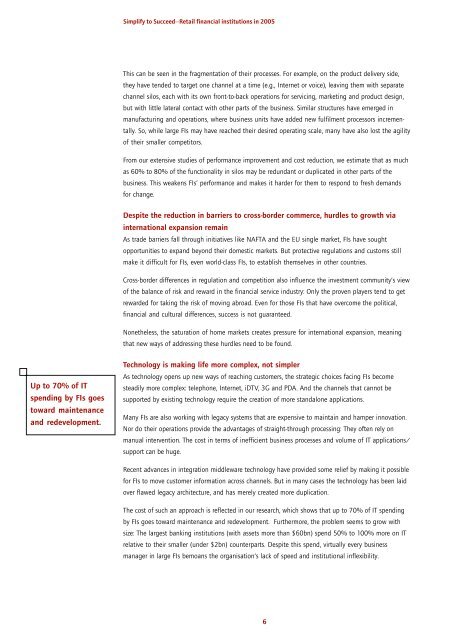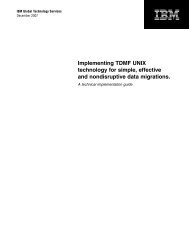Create successful ePaper yourself
Turn your PDF publications into a flip-book with our unique Google optimized e-Paper software.
Up <strong>to</strong> 70% of IT<br />
spending by FIs goes<br />
<strong>to</strong>ward maintenance<br />
and redevelopment.<br />
<strong>Simplify</strong> <strong>to</strong> <strong>Succeed</strong>—Retail financial institutions in 2005<br />
This can be seen in the fragmentation of their processes. For example, on the product delivery side,<br />
they have tended <strong>to</strong> target one channel at a time (e.g., Internet or voice), leaving them with separate<br />
channel silos, each with its own front-<strong>to</strong>-back operations for servicing, marketing and product design,<br />
but with little lateral contact with other parts of the business. Similar structures have emerged in<br />
manufacturing and operations, where business units have added new fulfilment processors incrementally.<br />
So, while large FIs may have reached their desired operating scale, many have also lost the agility<br />
of their smaller competi<strong>to</strong>rs.<br />
From our extensive studies of performance improvement and cost reduction, we estimate that as much<br />
as 60% <strong>to</strong> 80% of the functionality in silos may be redundant or duplicated in other parts of the<br />
business. This weakens FIs’ performance and makes it harder for them <strong>to</strong> respond <strong>to</strong> fresh demands<br />
for change.<br />
Despite the reduction in barriers <strong>to</strong> cross-border commerce, hurdles <strong>to</strong> growth via<br />
international expansion remain<br />
As trade barriers fall through initiatives like NAFTA and the EU single market, FIs have sought<br />
opportunities <strong>to</strong> expand beyond their domestic markets. But protective regulations and cus<strong>to</strong>ms still<br />
make it difficult for FIs, even world-class FIs, <strong>to</strong> establish themselves in other countries.<br />
Cross-border differences in regulation and competition also influence the investment community’s view<br />
of the balance of risk and reward in the financial service industry: Only the proven players tend <strong>to</strong> get<br />
rewarded for taking the risk of moving abroad. Even for those FIs that have overcome the political,<br />
financial and cultural differences, success is not guaranteed.<br />
Nonetheless, the saturation of home markets creates pressure for international expansion, meaning<br />
that new ways of addressing these hurdles need <strong>to</strong> be found.<br />
Technology is making life more complex, not simpler<br />
As technology opens up new ways of reaching cus<strong>to</strong>mers, the strategic choices facing FIs become<br />
steadily more complex: telephone, Internet, iDTV, 3G and PDA. And the channels that cannot be<br />
supported by existing technology require the creation of more standalone applications.<br />
Many FIs are also working with legacy systems that are expensive <strong>to</strong> maintain and hamper innovation.<br />
Nor do their operations provide the advantages of straight-through processing: They often rely on<br />
manual intervention. The cost in terms of inefficient business processes and volume of IT applications/<br />
support can be huge.<br />
Recent advances in integration middleware technology have provided some relief by making it possible<br />
for FIs <strong>to</strong> move cus<strong>to</strong>mer information across channels. But in many cases the technology has been laid<br />
over flawed legacy architecture, and has merely created more duplication.<br />
The cost of such an approach is reflected in our research, which shows that up <strong>to</strong> 70% of IT spending<br />
by FIs goes <strong>to</strong>ward maintenance and redevelopment. Furthermore, the problem seems <strong>to</strong> grow with<br />
size: The largest banking institutions (with assets more than $60bn) spend 50% <strong>to</strong> 100% more on IT<br />
relative <strong>to</strong> their smaller (under $2bn) counterparts. Despite this spend, virtually every business<br />
manager in large FIs bemoans the organisation’s lack of speed and institutional inflexibility.<br />
6

















